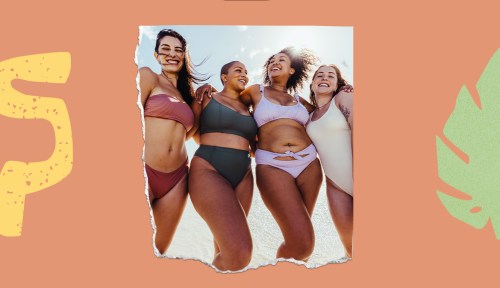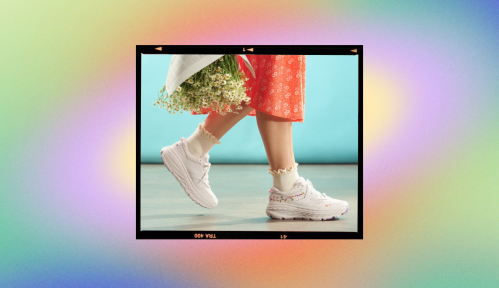Our editors independently select these products. Making a purchase through our links may earn Well+Good a commission
You’ve probably heard the phrase, “every body is a beach body.” Maybe you spotted the slogan alongside vibrant full-body photos: larger bodies and smaller ones basking in the sun, a smorgasbord of dimples, skin tones and scars. Maybe you’ve spied the words next to bodies in wheelchairs or bodies with amputated limbs. Maybe the phrase was underneath a bikini model with body hair. Perhaps the stream of diverse, beautiful beach bodies made you feel more comfortable in your own.
Experts in This Article
Caroline Quinn is a fat activist and confidence coach.
Queer therapist and body liberationist.
Virgie Tovar is an author, activist and one of the nation’s leading experts and lecturers on weight-based discrimination and body image. She holds a Master’s degree in Sexuality Studies with a focus on the intersections of body size, race and gender. She is a contributor for Forbes where she covers the plus-size market and how to end weight discrimination at work. She started the hashtag campaign #LoseHateNotWeight and in 2018 gave a TedX talk on the origins of the campaign. Tovar edited the anthology Hot & Heavy: Fierce Fat Girls on Life, Love and Fashion (Seal Press, November 2012) and she’s the author of You Have the Right to Remain Fat (Feminist Press August 2018), which was placed on the American Library Association’s Amelia Bloomer List, and The Self-Love Revolution: Radical Body Positivity for Girls of Color (New Harbinger Publications 2020). Her podcast, Reb
Yes, all body types belong at the beach, but that doesn’t mean all of your insecurities are erased. “Even now, when someone says ‘beach body’ a very specific image pops up in my head, and it’s not me,” says Caroline Quinn, a fat activist and confidence coach, adding that the “beach body” moniker is often bestowed on thin, cisgender white women, with blonde hair, blue eyes and flat stomachs.
Representation can be transformative, but it can’t undo years of internal and external shame. Fatphobia—or discrimination and bias directed at fat people and their bodies—is longstanding and pervasive. So even if you embrace body positivity intellectually, you might move away from guilt around not having a “perfect” body and feel shame that you don’t love your body enough.
This pressure to love your body unconditionally predates this current wave of body acceptance, says Virgie Tovar, author of The Body Positive Journal and host of the Rebel Eaters Club podcast. Body positivity began as the Fat Acceptance movement in the 1960s and aimed to fight weight biases and discrimination against fat people. Even then, people who identified with the movement struggled with feeling as if they weren’t doing it right, Tovar says. They grappled with the idea that if they didn’t feel comfortable wearing certain clothing, they might not be allowed to call themselves fat positive.
However, there are many steps between internalized fatphobia and body acceptance, says body liberation therapist Dani Bryant, MS, LMHC, RDT. “Sometimes it’s a movement from body dislike to body tolerance to body connection, to body freedom, to body joy,” she says. In short: It’s okay if you’ve embraced “every body is a beach body” in your head, but haven’t taken your bikini body to the ocean yet.
To help provide a clearer pathway for those of us in progress, we spoke with Quinn, Tovar, and Bryant about how to address lingering shame and insecurity, so you can connect with your body as it is. The first thing to note: You’re far from alone. Limited beach body definitions exclude most people, so many of us have to embark on the messy journey toward accepting, and maybe eventually loving, our bodies.
5 ways to get more comfortable with your beach body
1. Take time to really look at yourself
“If you avoid your own reflection, you’re going to feel uncomfortable when other people are around,” Quinn says. People who feel that their body is “bad” may not linger in front of mirrors and avoid taking pictures of themselves. So the first step is to get comfortable with your reflection. “Look at yourself in a bikini, look at yourself when you’re sitting down in a bikini,” Quinn says. “Look in the mirror, turn around, bend over, scrunch up. See all of it so you’re not surprised.”
2. Wear the swimsuit that feels most comfortable
This might sound like a no-brainer, but the thing about trying to love your body is that you might push yourself outside of your comfort zone. Challenging yourself is fine, but you don’t have anything to prove. “I’m a skimpy bikini girl. I like my belly, butt, and arms out,” Quinn says. “But if that’s not your thing, don’t do it because that’s what you think you’re supposed to do.”
Find a swimsuit that feels good to you, whether it’s a one-piece, a high-waisted bikini, a tankini, or shorts and a top. Any swimsuit you wear is the right one as long as it’s what makes you feel good and isn’t what you think other people want to see you in. “The more you hide, the more you’re telling yourself your body is bad and you can’t be comfortable in these spaces,” Quinn says.
That said, you may sometimes have to be wary of safety. Tovar explains that as a fat woman she has multiple bikinis, some for when she’s completely safe with people she trusts, and others for public swimming. “Take a risk, but not a huge risk,” she says. “There’s a difference between ‘I don’t feel good about myself’ and ‘it’s not safe for me to be in this body in this place.’”
3. Pay attention to the diversity of bodies at the beach
Have you ever really looked at the people at the beach? If you have, then you’ve probably noticed that the beach isn’t full of people who look like Pamela Anderson and David Hasselhoff. Shows like Baywatch paint an unrealistic picture of what being at the beach looks like. “If you actually go to the beach and sit down and seriously look at everybody, virtually nobody looks like that,” Quinn says. Noticing older people, people with visible stretch marks, people who have large bellies, people of many different skin colors, and all of the other diverse bodies can help you see that you do actually fit in at the beach.
4. Put blame where it belongs
Body positivity may feel like a personal problem—all about whether or not you love your body. However, Tovar reminds us that body positivity and fat liberation movements were born from a “demand on society to create more space and accessibility for all bodies to feel safe.”
When you lose sight of the institutional aspects of body acceptance, it can start to feel like you’re a traitor or a disappointment for struggling to love your body. “It’s important to note that when we’re making the demand on society, we’re saying an individual shouldn’t have to work so hard to be able to have one day of fun in the sun,” Tovar says.
Quinn adds that it can be powerful to think deeply about who actually spends their time judging your body. “People who actually like themselves don’t give a fuck about what I look like and what I’m doing,” she says. Recognize that the dirty looks or comments people might throw your way are a lot more about how they feel about their own bodies.
5. Honor yourself
Finally, it’s important to celebrate your accomplishments. You put on a swimsuit and went to the beach even though it was scary. And, hopefully, you had a blast. Celebrate yourself for doing something you found difficult—and know that you’re allowed to take all of your feelings with you.
You’ve likely heard the phrase, “Every body is a beach body,” right? Still, navigating the summer can be challenging. This week, Well+Good is publishing All Bodies Are Beach Bodies—A Realistic Guide to Preparing for Summer to help you hold on to your confidence, embrace joyful movement, manage sweat, make meaningful memories, and find major swimsuit inspiration all summer long.
Sign Up for Our Daily Newsletter
Get all the latest in wellness, trends, food, fitness, beauty, and more delivered right to your inbox.
Got it, you've been added to our email list.











